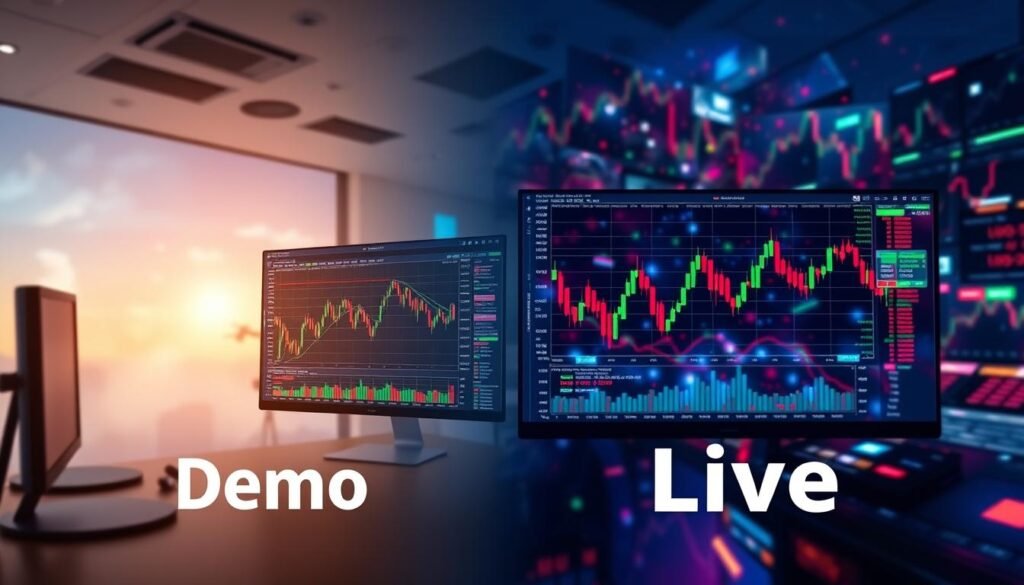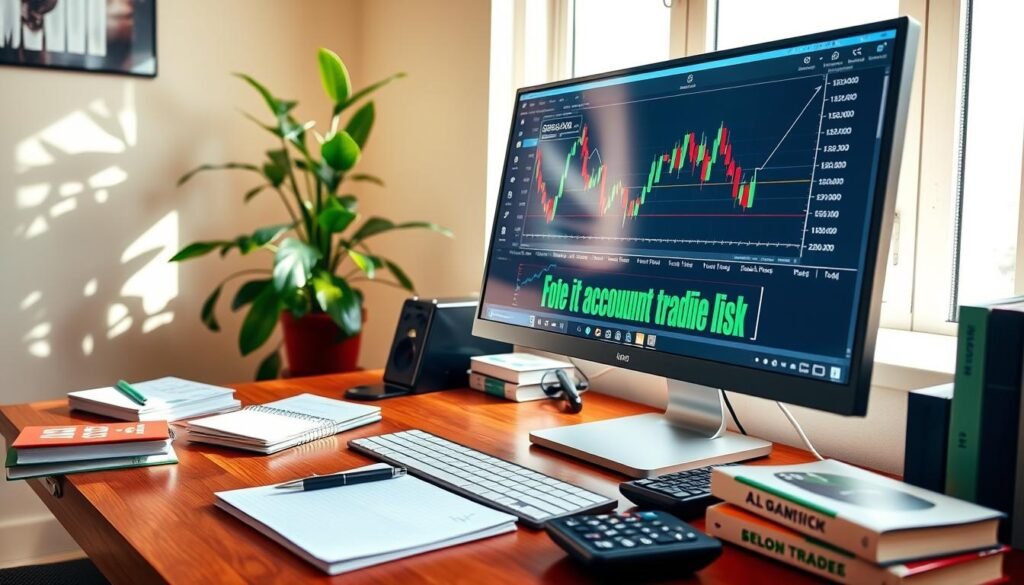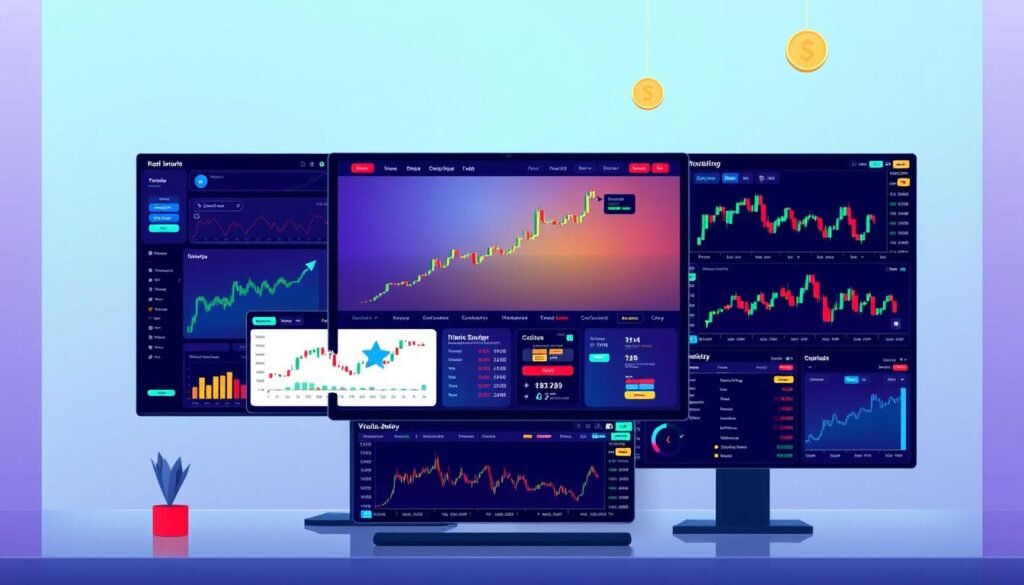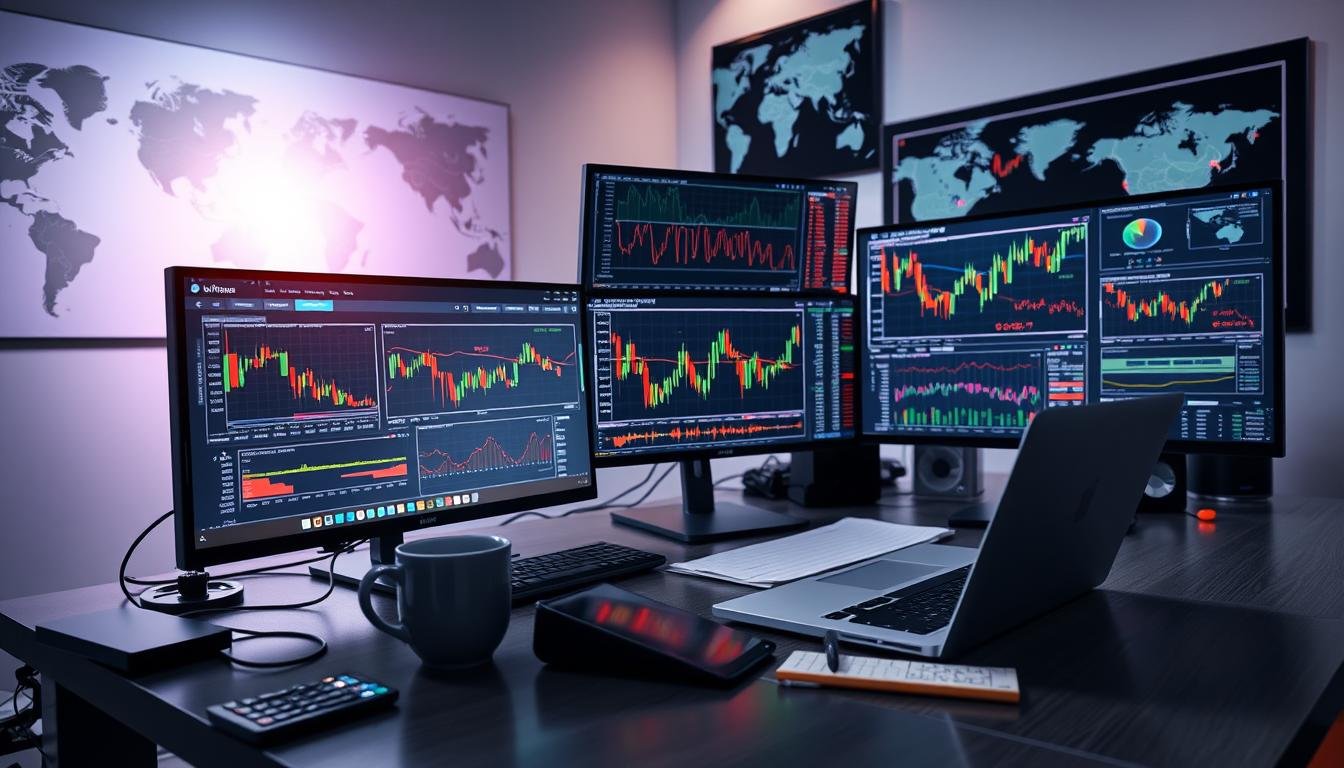Try Forex Demo Account: Risk-Free Trading
In the world of Forex trading, getting real experience is key. Luckily, Forex demo accounts let traders practice without risk. These platforms are perfect for testing strategies and getting to know the trading platform.
With a Forex demo account, you can learn about currency trading without worrying about losing money. This safe space lets you make mistakes and improve your skills. You can then apply what you’ve learned to real trading when you’re ready.
Key Takeaways
- Forex demo accounts provide a risk-free environment to practice trading and test strategies.
- These virtual platforms allow you to familiarize yourself with the trading platform without risking real capital.
- Practicing on a demo account can help you build confidence and develop a robust trading plan before transitioning to live trading.
- Forex demo accounts offer an invaluable opportunity to hone your skills and gain hands-on experience in the currency markets.
- Leveraging a demo account can be a crucial step in your Forex trading journey, paving the way for successful live trading.
What is a Forex Demo Account?
A Forex demo account is a place to practice trading without real money. It lets traders get used to the trading platform and try out strategies. This way, they can learn and improve their skills before using real money.
Definition and Purpose
A Forex demo account is like a virtual trading space. It shows what the Forex market is like in real time. Traders can try out trading without losing money. It’s a safe space to learn and get better before trading with real money.
Benefits of Using a Demo Account
- Try out different trading strategies without losing money
- Learn how to use the trading platform and its tools
- Get better at trading in a safe place
- Practice good money management and build confidence
- Understand the Forex market better, including its ups and downs
Using a Forex demo account helps traders improve their skills and test new strategies. It’s a safe way to learn and grow. This approach can help traders succeed in the Forex market over time.
Getting Started with a Forex Demo Account
Starting your Forex trading journey means finding a good Forex broker. This is key because your broker affects your trading experience. When searching for a reputable Forex broker, look for ones that are regulated and offer a good demo account.
Choosing a Reputable Forex Broker
To open a Forex demo account, you need to compare different brokers. Look at their regulatory status, trading platform, customer support, and tools. Also, check reviews and choose brokers that are open, secure, and care about their customers.
Opening a Demo Account
After picking a good Forex broker, setting up a demo account is easy. Most brokers have a simple sign-up process. You just need to give some basic info and you’re ready to practice trading without risk.
“A Forex demo account is your gateway to risk-free trading, enabling you to explore the market and refine your strategies without the worry of losing real money.”
By finding a reputable Forex broker and setting up a Forex demo account, you’re on your way to becoming a skilled Forex trader.
| Broker | Regulation | Demo Account | Trading Platform |
|---|---|---|---|
| XYZ Forex | FCA, ASIC | Yes | MetaTrader 4, cTrader |
| ABC Financial | CySEC, IFSC | Yes | MT5, proprietary platform |
| Acme Forex | FINRA, NFA | Yes | TradingView, OANDA |
Practicing Risk-Free Trading Strategies
A Forex demo account lets traders try out different trading strategies without losing real money. It’s a safe space to test various entry and exit points. Traders can also try out technical indicators and analysis tools. This practice helps improve their skills and confidence for live trading.
Using a demo account for Forex trading has many benefits:
- Trying new trading techniques without losing money
- Learning more about market dynamics and price changes
- Finding and fixing weaknesses in your trading style
- Getting better at using trading platform tools
- Practicing in a simulated market
Testing trading methods in a risk-free environment gives you valuable insights. It helps you refine your skills before trading with real money. This way, you can build a strong foundation for success in live Forex trading.
| Trading Technique | Potential Benefits |
|---|---|
| Trend-Following Strategies | Identifying and capitalizing on sustained market movements |
| Breakout Strategies | Capturing opportunities during periods of increased volatility |
| Swing Trading Approaches | Profiting from medium-term price swings in the market |
Using a Forex demo account lets you practice forex trading strategies, test trading approaches, and create a solid trading plan. This experience is crucial for becoming a successful Forex trader.
“Practicing in a demo account allows me to fine-tune my trading strategies without the emotional burden of risking real capital. It’s an essential step in my path to becoming a confident and profitable Forex trader.”
Mastering Technical Analysis with a Demo Account
Forex demo accounts are great for traders learning technical analysis. They offer a safe space to learn about different charts and indicators. You can try out various tools without risking real money.
Understanding Charts and Indicators
In a Forex demo account, you can explore many chart types. These include line charts, candlestick charts, and bar charts. By looking at these charts, you can understand price trends and patterns better.
You can also try out technical indicators like moving averages and Relative Strength Index (RSI). These tools help spot trading opportunities and improve your market analysis skills.
Developing a Forex Trading Plan
Forex demo accounts are perfect for creating a trading plan. You can test your strategies and learn about risk management. This way, you can track your performance without losing real money.
By refining your plan in a demo account, you gain confidence and discipline. This is crucial for success in the live Forex market.
| Technical Analysis Tool | Description | Potential Applications |
|---|---|---|
| Moving Averages | Smoothed line that tracks the average price over a specified period | Identifying trend direction and potential support/resistance levels |
| Relative Strength Index (RSI) | Momentum oscillator that measures the speed and change of price movements | Detecting overbought and oversold market conditions |
| Bollinger Bands | Volatility indicator that plots two standard deviation lines above and below a moving average | Identifying price breakouts and potential support/resistance areas |
By mastering technical analysis in a Forex demo account, traders gain a deep understanding of the market. They can test strategies and build the skills and confidence needed for live Forex trading.
“The real key to making money in the markets is not to get caught up in the daily swings, but to have a solid trading plan and stick to it.” – Peter Lynch
Forex Demo Account: Risk-Free Trading
Using a forex demo account lets traders trade without risk. They can try out different strategies and see how they work without losing money. This way, they can learn and improve without worrying about losing real cash.
Trading with a demo account is a safe space for new traders to get better. It’s perfect for those just starting out. They can try out different ways of trading and see what works best for them.
Even seasoned traders can use a forex demo account to try new things. They can test their strategies and see how they do. This helps them improve their trading without risking their real money.
“A forex demo account is a game-changing tool for traders of all skill levels. It allows you to practice forex trading without risk and perfect your strategies before committing real capital.”
Trading with a demo account helps build confidence and skills. It lets traders understand the market better without fear of losing money. This practice can lead to better trading decisions when they start trading for real.
Transitioning from Demo to Live Trading
Switching from a Forex demo account to live trading is both thrilling and challenging. It’s crucial to have realistic goals. Live trading feels different from demo trading. Traders must handle risk and emotions well to do well.
Setting Realistic Expectations
One big hurdle is managing your hopes. Demo accounts are great for practice, but live markets are unique. Be ready for market ups and downs, and the stress of using your own money. A good trading plan and discipline are key for a smooth move.
Managing Risk and Emotions
When you start trading with real money, managing risk is vital. Make sure your trades fit your account size and how much risk you can take. Keeping your emotions in check is also important. The rush of live trading can lead to quick, bad decisions.
Skills from demo trading can help you succeed in live trading. By setting the right expectations, managing risk, and staying calm, you can make a profitable switch.

“The true test of a trader’s mettle comes when they put their own capital on the line. Mastering the emotional and risk management aspects of live trading is the key to long-term success.”
Advanced Trading Techniques with Demo Accounts
Forex demo accounts give traders a great chance to try out advanced trading methods. They can test automated trading and backtest strategies in a safe space. This lets traders see how their plans work out without losing money.
Automated Trading and Backtesting
Automated trading uses computer programs to make trades based on set rules. Demo accounts are perfect for testing these systems without risk. By backtesting, traders can check how their strategies did in the past. This helps them spot what works and what needs work.
- Develop and fine-tune algorithmic trading strategies in a risk-free environment
- Backtest trading strategies using historical market data to evaluate their performance
- Gain valuable insights into the effectiveness and reliability of your trading approaches
| Technique | Benefits | Potential Drawbacks |
|---|---|---|
| Automated Trading |
|
|
| Backtesting |
|
|
Forex demo accounts are key for mastering advanced trading techniques. They let traders try out automated trading and backtesting without risk. This safe space helps traders improve their strategies, making them more confident in real trading.
Tips for Maximizing Your Demo Account Experience
Exploring Forex trading is exciting, and a demo account is key for learning before trading live. Here are some tips to make the most of your demo account:
- Set Clear Trading Goals: Have specific goals for your demo trading, like testing new strategies or improving risk management. This keeps you focused and motivated.
- Regularly Review and Analyze Your Performance: Watch your trades closely, track wins and losses, and figure out what worked. Use this info to improve your trading.
- Continually Learn and Adapt: Keep up with market trends and news. Update your trading plan as you learn and grow.
- Simulate Real-World Conditions: Act as if you’re trading for real. Use the same discipline and risk management you would in real trading.
- Leverage Demo Account Features: Use the tools and features your demo account offers, like automated trading. These can help you get better at trading.
By following these tips, you can get the most out of your Forex demo account. This will help you when you start trading for real. The more you practice in the demo account, the more ready you’ll be for the real Forex market.

“The real value of a Forex demo account lies in the opportunity to refine your trading strategies without risking real capital. Take full advantage of this risk-free environment to hone your skills and build your confidence.”
Common Mistakes to Avoid with Demo Trading
Forex demo accounts are great for learning without risk. But, it’s key to watch out for common mistakes. Overconfidence and not managing risk well are two big ones to avoid.
Overconfidence and Lack of Discipline
Demo trading can lead to overconfidence. Traders might feel too safe and make bad choices. This can hurt them when they start trading for real money.
Disregarding Proper Risk Management
Ignoring risk management is another big mistake in Forex demo trading. Traders might think they don’t need to manage risk because it’s not real money. But, this is a big mistake for live trading.
To stay safe, traders should be just as careful with demo accounts as they would with real money. Good habits and a smart mindset help make the switch to live trading easier.
“Treat your demo account like a live trading account, and your live trading account like a demo account.”
Exploring Additional Trading Features
Forex demo accounts offer more than just basic trading. Brokers now provide advanced tools and features. These can improve your learning experience and help you understand the Forex market better.
One key feature is sophisticated charting tools. These tools let you analyze market trends and find trading opportunities. You can customize charts and use advanced drawing tools to improve your skills without risk.
Another great feature is automated trading. Some platforms let you test and refine trading strategies. This way, you can see how your ideas perform without losing real money. It’s perfect for those interested in algorithmic trading.
- Advanced charting tools for in-depth technical analysis
- Automated trading and backtesting capabilities
- Economic calendars and news feeds to stay informed
- Social trading features to observe and learn from experienced traders
Forex demo accounts with these features can change how you learn. They let you explore the market, test strategies, and gain insights. These can help you when you start trading for real.

“Exploring the expanded functionality of Forex demo platforms can unlock a wealth of learning opportunities and help you become a more well-rounded trader.”
Integrating Demo Trading with Educational Resources
Using a demo account in Forex trading is very helpful. It gives you real experience without risk. But, to get the most out of it, you should also use educational resources. This way, you learn more about the Forex market and improve your trading skills.
Online Courses and Webinars
Online Forex trading courses are great to go along with demo trading. They teach you about market analysis and trading techniques. This mix of practice and theory helps you understand Forex better.
Also, webinars with industry experts are very useful. They offer live advice and a chance to ask questions. You can learn a lot from these sessions.
Trading Communities and Forums
Trading communities and forums are also very helpful. They have discussions and experiences from other traders. You can learn from their successes and challenges.
Many communities also have educational materials for demo users. These resources help you stay updated and improve your skills.
| Educational Resource | Benefits for Forex Demo Trading |
|---|---|
| Online Courses | Comprehensive theoretical knowledge, complementing hands-on demo experience |
| Webinars | Real-time insights and guidance from industry experts |
| Trading Communities | Shared experiences, discussions, and educational resources tailored for demo traders |
By combining Forex demo trading with different educational resources, you get a full understanding of the market. You can also improve your trading strategies. This prepares you well for trading with real money.
Choosing the Right Live Trading Account
Switching from a Forex demo to a live trading account is a big step. It’s important to pick the right account that fits your trading goals and how much risk you’re willing to take. Look at the broker’s reputation, the trading platform, the minimum account balance, leverage options, and trading conditions.
When selecting a live Forex trading account, check the broker’s reputation and if they follow the rules. A good broker offers a safe place to trade, protecting your money.
The trading platform’s features are also key. It should be easy to use, have good charting tools, and offer many order types. Also, having access to educational resources and customer support can make your trading experience better.
| Factor | Importance |
|---|---|
| Broker Reputation | High |
| Trading Platform Features | High |
| Account Minimums | Moderate |
| Leverage Options | Moderate |
| Trading Conditions | High |
When transitioning from a Forex demo to a live account, be realistic and manage your risk well. Start with a small account and grow it as you get more confident. Using stop-loss orders can help protect your money and reduce losses.
“The key to successful Forex trading is not just about selecting the right live account, but also developing a solid trading plan and maintaining discipline throughout your trading journey.”
By thinking about these points and being careful, you can choose the right live Forex trading account. This will help you succeed in the Forex market over time.
Ongoing Practice with Demo Accounts
Even the most experienced Forex traders can still learn a lot from demo accounts. They can test new strategies, try out different market conditions, and improve their skills without risk. This keeps them sharp and helps them find areas to get better.
Using demo accounts regularly has many benefits. Traders can improve their decision-making, learn better risk management, and try out new tactics without losing money. This safe space helps them understand the market better and create a solid trading plan.
Adding demo trading to your Forex learning routine can lead to success over time. It lets traders keep their skills sharp, stay current with market changes, and build confidence for live trading. This practice is key to doing well in the Forex world.
“Consistent practice with a forex demo account is the key to unlocking your full potential as a trader. It’s a risk-free way to sharpen your skills and stay ahead of the curve.”
By always using a forex demo account, traders can be ready to take advantage of market chances. They can move through the changing Forex world with skill and confidence.
| Benefits of Practicing with Forex Demo | Maintaining Proficiency with Forex Demo Trading |
|---|---|
|
|
Conclusion
Forex demo accounts are a great way for traders to improve their skills without risk. They let traders try out different strategies and get used to the trading platform. This helps build the discipline and confidence needed for live trading.
Using a Forex demo account has many benefits. It lets you practice trading without losing real money. This makes it a safe place to learn and grow. You can also learn technical analysis and develop a trading plan.
When you move to live trading, it’s important to have realistic expectations. You should manage risk well and control your emotions. The skills you learn from demo trading will help you make better decisions in the live markets. This can lead to long-term success in trading.
FAQ
What is a Forex Demo Account?
A Forex demo account lets you trade without real money. It’s a safe place to try out trading strategies. You can get used to the trading platform and improve your skills before using real money.
What are the Benefits of Using a Forex Demo Account?
Using a Forex demo account lets you try different trading methods. You can learn from mistakes without losing money. It also helps you build confidence in the market.
How do I Get Started with a Forex Demo Account?
To start, choose a reputable Forex broker. Opening a Forex demo account is easy. You just need to provide some personal details and set it up.
How can I Practice Risk-Free Trading Strategies with a Forex Demo Account?
A Forex demo account lets you try out trading strategies without risk. You can test different entry and exit points. It’s a great way to learn and improve your skills.
How can I Master Technical Analysis with a Forex Demo Account?
Forex demo accounts are great for learning technical analysis. You can practice reading charts and using technical indicators. They help you develop a solid trading plan.
What are the Benefits of Transitioning from a Forex Demo Account to Live Trading?
Trading with a demo account prepares you for live trading. But, live trading is different. It’s important to manage your risk and emotions well.
What Advanced Trading Techniques can I Explore with a Forex Demo Account?
Forex demo accounts let you try advanced trading techniques. You can test automated trading and backtesting. This helps you see how they work before using them in real trading.
What Tips can I Follow to Maximize my Forex Demo Account Experience?
To make the most of a Forex demo account, be disciplined and committed. Set clear goals and review your performance often. Keep learning and adapting your strategies.
What Common Mistakes should I Avoid with Forex Demo Trading?
Don’t get too confident or lack discipline with a Forex demo account. Also, don’t ignore risk management strategies. They’re important for live trading too.
What Additional Trading Features can I Explore with a Forex Demo Account?
Many Forex brokers offer demo accounts with extra features. You can find advanced charting tools, automated trading, and more. These features can help you learn and improve.
How can I Integrate Forex Demo Trading with Educational Resources?
Use your Forex demo account with educational resources. Online courses, webinars, and trading communities can help. They enhance your learning and improve your trading skills.
How do I Choose the Right Live Trading Account after Forex Demo Trading?
After demo trading, choose a live trading account wisely. Look at the broker’s reputation, platform features, and trading conditions. These factors are important for a good trading experience.
How can I Maintain Ongoing Practice with Forex Demo Accounts?
Even experienced traders should keep practicing with demo accounts. Try new strategies and test different market conditions. It keeps you sharp and helps you improve.
